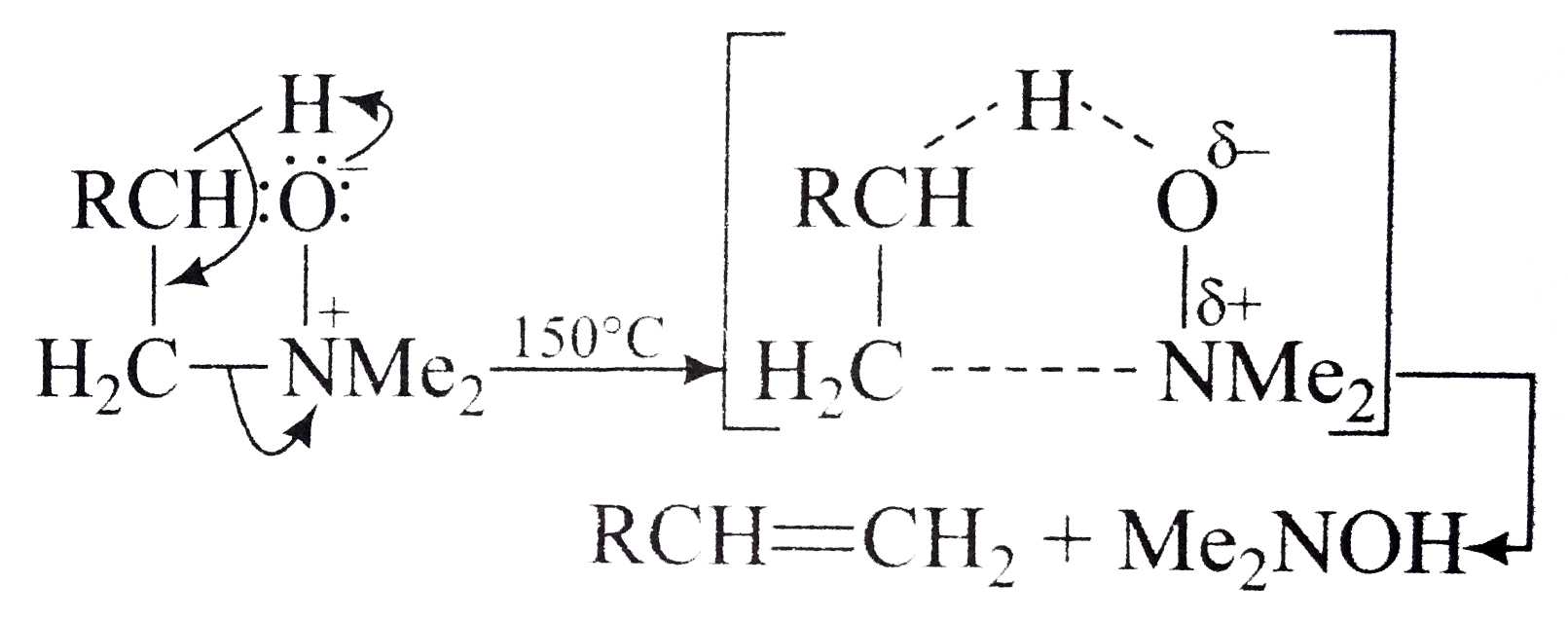Tertiary amine oxides undergo the elimination of a dialkyihydroxylamine when they are heated This reaction is called the .
Cope elimination
Hofmann elimination
Saytzeff elimination
Markovnikov' s elimination
The correct Answer is:A
RCH2CH2A tertiaryamine oxide:..O:−∣N+∣CH3−C150∘C−−−→RCH=CH2An alkene+::..OH∣N∣CH3−CH3N,N-Dimethyl-hydroxyl amine
This is the Coper reaction in which alkenes are formed when amine oxides are heated it is a syn elimination and proceed through a cyclic transition state The cope elimination is useful synthetically as illustrated by the synthesis of methylenecyclohexane


Topper's Solved these Questions
- BOOK - R SHARMACHAPTER - AMINESEXERCISE - Follow -up Test 31videos
AMINES
- BOOK - R SHARMACHAPTER - AMINESEXERCISE - Follow -up Test 41videos
AMINES
- BOOK - R SHARMACHAPTER - AMINESEXERCISE - Follow -up Test 21videos
AMINES
- BOOK - R SHARMACHAPTER - ALCOHOL, PHENOL AND ETHERSEXERCISE - ETHERS level IV7videos
ALCOHOL, PHENOL AND ETHERS
- BOOK - R SHARMACHAPTER - BIOMOLECULESEXERCISE - Archives47videos
BIOMOLECULES
Similar Questions
Knowledge Check
- Question 1 - Select One
Tertiary amine is obtained in the reaction
AAniline CH3l−−→CH3l−−→BAniline CH3l−−→CNitrobezeneSn/HCl−−−−→DNone of these - Question 2 - Select One
Tertiary amine is oxidized to oxide by
AKMnO4BH2O2CK2Cr2O7Dall of theses - Question 3 - Select One
Amine oxide , when heated , forms alkene. This reaction is called
ACope eliminationBCurtius reactionCHoffmann eliminationDMannich reaction
When haloalkanes with Bη-hydrogen atom are boiled with alcoholic solution of KOH, they undergo elimination of hyarogen halide resulting in the formation of alkenes. These reactions are called Bη-elimination reactions or dehydrohalogenation reactions. These reactions follow Saytzeff's rule. Substitution and elimination reactions often compete with each other. Mostly bases behave as nucleophiles and therefore can engage in substitution or elimination reactions depending upon the alkyl halide and the reaction conditions.
In the elimination reactions, the reactivity of alkyl halides follow the sequenceView SolutionWhen haloalkanes with β-hydrogen atom are boiled with alcoholic solution of KOH, they undergo elimination of hyarogen halide resulting in the formation of alkenes. These reactions are called β-elimination reactions or dehydrohalogenation reactions. These reactions follow Saytzeff's rule. Substitution and elimination reactions often compete with each other. Mostly bases behave as nucleophiles and therefore can engage in substitution or elimination reactions depending upon the alkyl halide and the reaction conditions.
In the elimination reactions, the reactivity of alkyl halides follow the sequenceView SolutionWhen haloalkanes with β-hydrogen atom are boiled with alcoholic solution of KOH, they undergo elimination of hyarogen halide resulting in the formation of alkenes. These reactions are called β-elimination reactions or dehydrohalogenation reactions. These reactions follow Saytzeff's rule. Substitution and elimination reactions often compete with each other. Mostly bases behave as nucleophiles and therefore can engage in substitution or elimination reactions depending upon the alkyl halide and the reaction conditions.
The ease of dehydrohalogenation of alkyl halide with alcoholic KOH isView SolutionWhen haloalkanes with Bη-hydrogen atom are boiled with alcoholic solution of KOH, they undergo elimination of hyarogen halide resulting in the formation of alkenes. These reactions are called Bη-elimination reactions or dehydrohalogenation reactions. These reactions follow Saytzeff's rule. Substitution and elimination reactions often compete with each other. Mostly bases behave as nucleophiles and therefore can engage in substitution or elimination reactions depending upon the alkyl halide and the reaction conditions.
The ease of dehydrohalogenation of alkyl halide with alcoholic KOH isView SolutionWhen haloalkanes with Bη-hydrogen atom are boiled with alcoholic solution of KOH, they undergo elimination of hyarogen halide resulting in the formation of alkenes. These reactions are called Bη-elimination reactions or dehydrohalogenation reactions. These reactions follow Saytzeff's rule. Substitution and elimination reactions often compete with each other. Mostly bases behave as nucleophiles and therefore can engage in substitution or elimination reactions depending upon the alkyl halide and the reaction conditions.
Among the following the most reactive towards alcoholic KOH isView Solution

